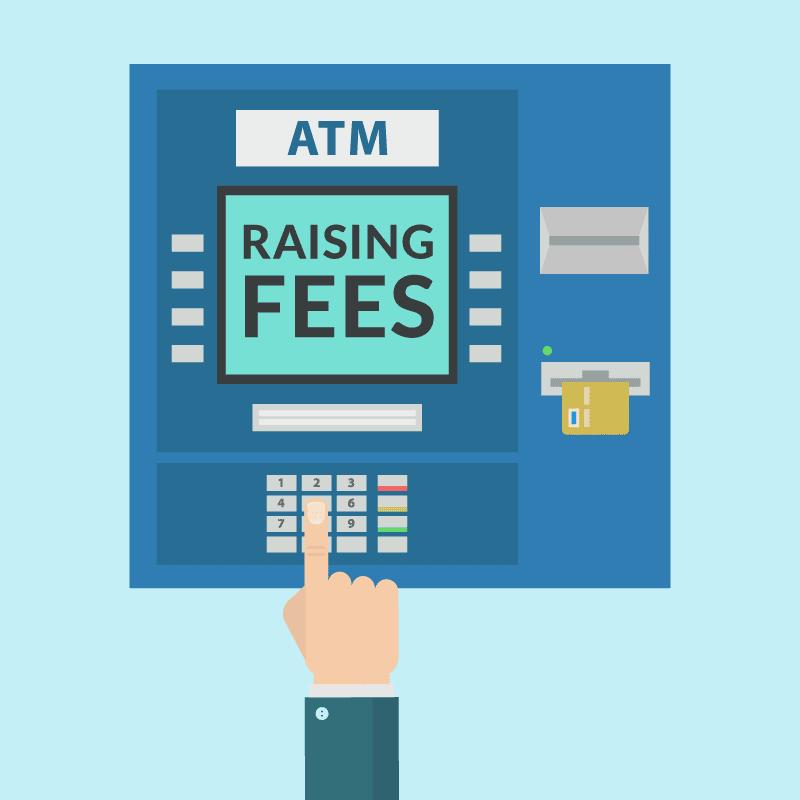Standing outside an ATM at two in the morning, Thomas Knapp couldn’t help but hear his economics professor’s words ringing in his ear: A dollar today is worth more than a dollar tomorrow.
Knapp had no idea ATM rates had vaulted 16% percent in the last five years and 37% over the last decade. All he knew was that the 2007 Jeep Commander parked behind the fence belonged to him, and the towing company told him it would be $105 to get it back— CASH ONLY!
To keep his car here another night would cost him an additional $25, so a dollar today would save him $25 tomorrow.
Conveniently there was an ATM outside, but inconveniently it charged 15% on the transaction to use it. He looked around the desolate corner of town outside the tow lot. The chances of finding a Wells Fargo ATM out here were hopeless. He was trapped and not very happy.
“I never carry that kind of cash around,” Knapp said. “It was shocking to have to pay that kind of fee for my own money. It felt like they were taking advantage of me.”
Knapp started the night just wanting to see one of his favorite local bands in concert, but things had suddenly become very expensive. Between the cab ride to the towing lot ($28), the fine to retrieve his car ($105), and the ATM fees ($16) to get the cash to pay the towing service, it started to feel like he should have seen Springsteen at Madison Square Garden.
Thomas bit the bullet, paid the fees, and sulked all the way home.
ATM Fees Continue to Rise
According to Bankrate.com’s annual checking survey, he has plenty of company biting the ATM bullet. The average cost of using an out-of-network ATM has risen from $3.62 in 2011to $4.57 per transaction in 2016.
That number varies across the country:
- The highest fees are in Phoenix ($5.07), Atlanta ($5.05), and Cleveland ($4.98).
- The lowest fees are in San Francisco ($3.90), Cincinnati ($3.92), and Dallas ($4.22).
Nationwide, the rate has set a record high in every year since 2006. Kevin Barker, a senior equity analyst at Piper Jaffray, a Minneapolis-based investment bank and asset management firm, told Bankrate.com: he expects ATM fees to continue to move higher.
Banks Under Pressure to Generate Income
The reason, he says, is that banks are under a lot of pressure to find income, and ATM fees are easy pickings. America’s three largest banks (JPMorgan Chase, Bank of America and Wells Fargo) earned more than $6 billion from ATM and overdraft fees, according to a report by SNL Financial and CNNMoney.
That breaks down to $25 profit from every adult in America. ATMs are a huge business. Nearly $250 billion is withdrawn from ATMs each year. As staggering as that number may be, the reality is that fewer people are using ATMs these days.
Between credit cards and debit cards people are using cash less than they did five years ago. Add new financial apps to the mix like Google Wallet, Venmo and Square Cash that make cash obsolete. These apps link to your bank account so that you can send and receive money from friends or businesses through your phone.
Millennials Eschew ATMs
Consumers, especially the Millennial generation, use the apps and quit relying on cash from ATMs. The downturn in use means ATM operators have no choice but to raise rates in order to make up the difference in income. They also need more revenue to upgrade and maintain the existing ATM networks.
If you are going to withdraw cash from an ATM, it is important to understand the fees you are paying and how you might be able to avoid them. With a little research and planning, there is no reason you can’t eliminate ATM fees from your monthly budget.
Two Categories of ATM Fees
ATM fees break down into two categories: non-customer withdrawal fees and out-of-network withdrawal fees.
Non-Customer Withdrawal Fees
Noncustomer withdrawal fees are charges from the bank or company that operates the ATM. This year the average was $2.90, but it can be a lot more if you are using an ATM that is unaffiliated with any bank, like those at a towing company, for example.
Out-of-Network Fees
Out-of-network withdrawal fees are surcharges from your own bank, a fee for using an ATM unassociated with your bank. This year the average was $1.67, a 1.8% increase from last year.
Those fees can certainly add up if you are routinely making withdrawals from an out-of-network ATM. A consumer making just one trip a week to one of those ATMs can waste $237 in fees a year.
Using an out-of-network ATM once in a blue moon won’t hurt you, but with so many alternatives there is never a reason to pay ATM fees.
5 Strategies to Avoid ATM Fees
- Always Have Cash on Hand – Withdraw cash from your bank once a week and make sure it is enough to last through the weekend.
- Only Use Your Bank’s ATMs – You can avoid the fees by staying in-network. Many banks now have an app you can download to map out where you can find their nearest ATM.
- Get Cash Back at the Grocery Store – While you’re stocking up on groceries for the week, why no stock up on the cash you’ll need for the week?
- Choose a Bank That Refunds ATM Fees – Many online banks such as Ally, USAA, and Simple refund ATM fees because they don’t have a physical location. Investment and brokerage firms like E*Trade, Fidelity, and Charles Schwab also offer accounts that reimburse ATM fees but beware there are minimum balance requirements. Do your research and find a no-fee checking account.
- Download Google Wallet, Venmo or Square Cash – You don’t have to take a trip to an ATM for an IOU. Instead, you can use one of these apps to transfer money to whomever you owe.

5 MINUTE READ
Home » InCharge Blog »
Sources:
- Cetera, M. (2016, October 4) The average cost of using an out of network ATM has risen to $4.57 per transaction. Retrieved from http://www.bankrate.com/finance/checking/2016-checking-account-survey-1.aspx
- Long, H. (2016, January 14) America’s three largest banks (JPMorgan Chase, Bank of America and Wells Fargo) earned more than $6 billion from ATM and overdraft fees. Retrieved from http://money.cnn.com/2016/01/14/investing/atm-overdraft-fees/index.html

















